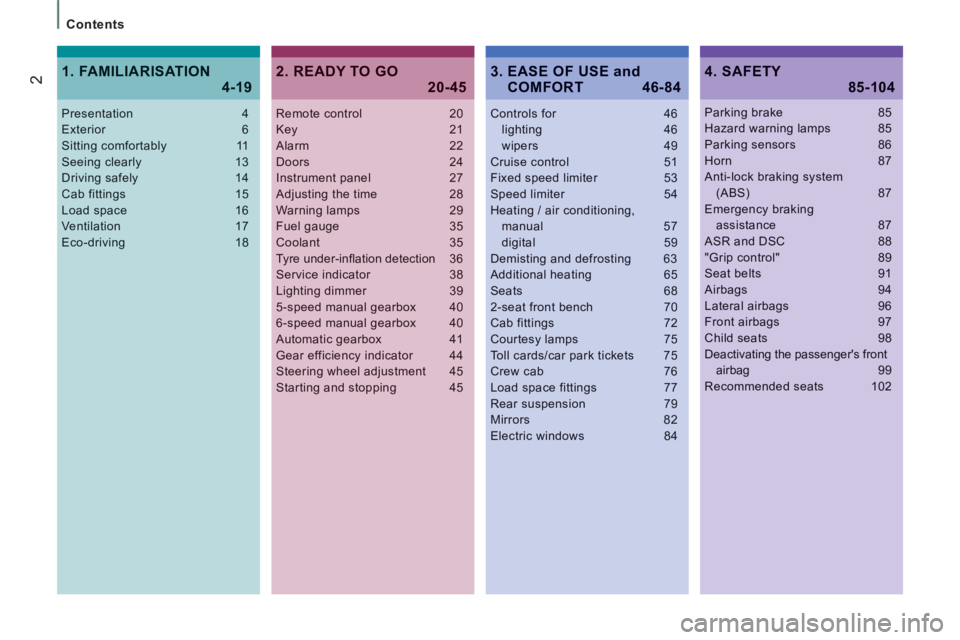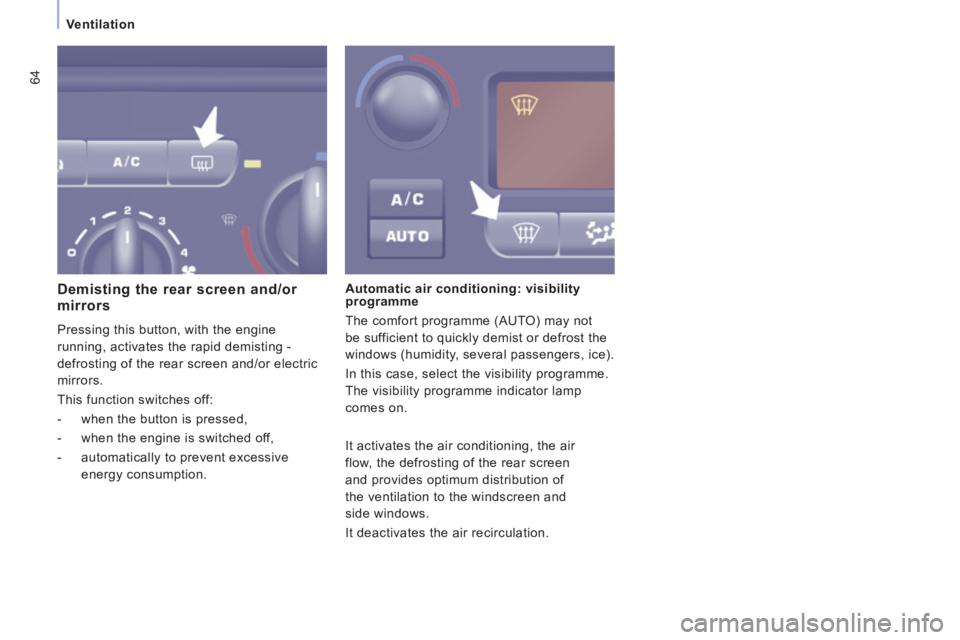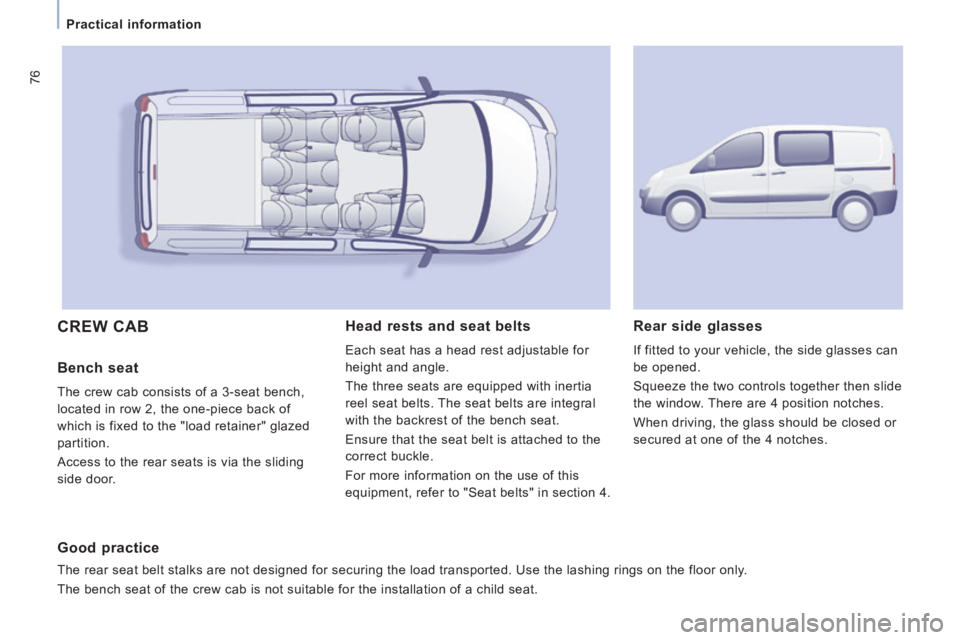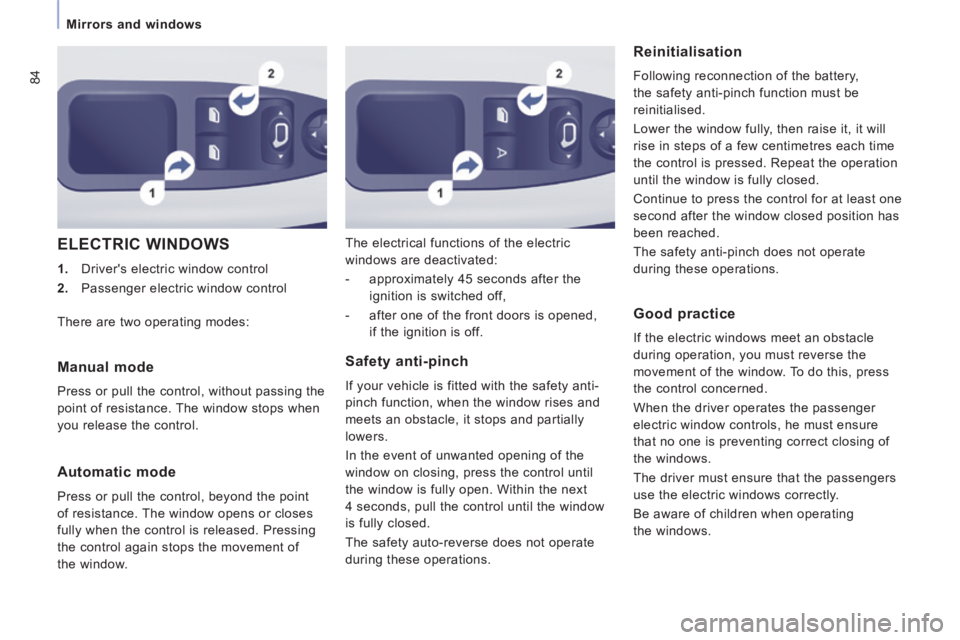window CITROEN JUMPY 2008 Owners Manual
[x] Cancel search | Manufacturer: CITROEN, Model Year: 2008, Model line: JUMPY, Model: CITROEN JUMPY 2008Pages: 252, PDF Size: 12.15 MB
Page 4 of 252

2
Contents
Remote control 20Key 21Alarm 22Doors 24Instrument panel 27Adjusting the time 28Warning lamps 29
Fuel gauge 35Coolant 35Tyre under-infl ation detection 36Service indicator 38Lighting dimmer 395-speed manual gearbox 406-speed manual gearbox 40Automatic gearbox 41Gear efficiency indicator 44Steering wheel adjustment 45Starting and stopping 45
Controls for 46 lighting 46 wipers 49Cruise control 51Fixed speed limiter 53Speed limiter 54Heating / air conditioning,
manual 57 digital 59Demisting and defrosting 63Additional heating 65Seats 682-seat front bench 70Cab fittings 72Courtesy lamps 75Toll cards/car park tickets 75Crew cab 76Load space fittings 77Rear suspension 79Mirrors 82Electric windows 84
2. READY TO GO 20-454. SAFETY 85-104
Presentation 4Exterior 6Sitting comfortably 11Seeing clearly 13Driving safely 14Cab fittings 15Load space 16
Ventilation 17Eco-driving 18
1. FAMILIARISATION 4-19
Parking brake 85Hazard warning lamps 85Parking sensors 86Horn 87Anti-lock braking system (ABS) 87Emergency braking assistance 87ASR and DSC 88"Grip control" 89Seat belts 91Airbags 94Lateral airbags 96Front airbags 97Child seats 98Deactivating the passenger's front airbag 99Recommended seats 102
3. EASE OF USE and COMFORT 46-84
Page 14 of 252

2
4
3
3
Interior
12
Seat belts Steering wheel
Electric windows
Door mirrors
44
91 84
82
Electric adjustments, electric folding /
unfolding.
Height adjustment.
Fastening. Adjust the steering wheel for height and
reach. Manual adjustments.
Page 20 of 252

18ECO-DRIVING
Eco-driving is a range of everyday practices that allow the motorist to \
optimise their fuel
consumption and CO
2 emissions.
Optimise the use of your
gearbox
With a manual gearbox, move off gently
and change up without waiting. During
acceleration change up early.
With an automatic or electronic gearbox,
give preference to automatic mode and
avoid pressing the accelerator pedal
heavily or suddenly.
Control the use of your
electrical equipment
Before moving off, if the passenger
compartment is too warm, ventilate it by
opening the windows and air vents before
using the air conditioning.
Above 30 mph (50 km/h), close the windows
and leave the air vents open. Switch off the headlamps and front
foglamps when the level of light does not
require their use.
Avoid running the engine before moving
off, particularly in winter; your vehicle will
warm up much faster while driving.
Drive smoothly
Maintain a safe distance between vehicles,
use engine braking rather than the
brake pedal, and press the accelerator
progressively. These practices contribute
towards a reduction in fuel consumption and
CO
2 emissions and also helps reduce the
background traffic noise.
If your vehicle has cruise control, make use
of the system at speeds above 25 mph
(40 km/h) when the traffic is flowing well.
As a passenger, if you avoid connecting
your multimedia devices (film, music,
video game...), you will contribute towards
limiting the consumption of electrical
energy, and so of fuel.
Disconnect your portable devices before
leaving the vehicle. Remember to make use of equipment
that can help keep the temperature in the
passenger compartment down (sunroof
and window blinds...).
Switch off the air conditioning, unless it
has automatic regulation, as soon as the
desired temperature is attained.
Switch off the demisting and defrosting
controls, if not automatic.
Switch off the heated seat as soon as
possible.
The gear efficiency indicator invites
you engage the most suitable gear: as
soon as the indication is displayed in the
instrument panel, follow it straight away.
For vehicles fitted with an electronic or
automatic gearbox, this indicator appears
only in manual mode.
Page 24 of 252

22
Access
ALARM
If fitted on your vehicle, this provides two
types of protection:
- exterior protection: it sounds if a front/rear door or the bonnet is opened.
- interior protection: it sounds if the volume inside the passenger
compartment changes (breaking of
a window or a movement inside the
vehicle).
Good practice
Do not make any modifications to the
electronic immobiliser system.
Operating the remote control, even when it
is in your pocket, may result in involuntary
unlocking of the doors.
The simultaneous use of other high
frequency equipment (mobile telephones,
domestic alarms…), may interfere with the
operation of the remote control temporarily.
The remote control does not operate while
the key is in the ignition, even if the ignition
is off.
If your vehicle is fitted with a separation
partition, the interior protection is not active
in the load space.
Locking the vehicle with complete
alarm
Setting the alarm
- Switch off the ignition and get out of the vehicle.
When purchasing a second-hand vehicle:
- have the keys memorised by a CITROËN dealer to ensure that the keys
in your possession are the only ones
which can start the vehicle. - Set the alarm within five minutes of
getting out of the vehicle, by locking or
deadlocking using the remote control.
The red LED, located on the centre
console, flashes once per second.
Disarming
- Unlock the vehicle with the remote control or switch on the ignition, the red
LED goes off.
Locking the vehicle with exterior
protection only
If, while you are away from the vehicle, you
wish to leave a window partially open or a
pet inside the vehicle, you should choose
exterior protection only.
- Switch off the ignition.
- In the next ten seconds, press this button, located on the
centre console, until the red
LED is on continuously.
- Get out of the vehicle.
- Within the next five minutes, set the alarm by locking or deadlocking using
the remote control (the red LED flashes
once a second).
When leaving the vehicle,
check that the lamps are
off and nothing of value is
visible.
As a safety precaution (with
children on board), remove
the key from the ignition
when leaving the vehicle,
even for a short time.
Page 64 of 252

62
Ventilation
CORRECT USE OF THE VENTILATION AND AIR CONDITIONING
Passenger compartment filter,
carbon filter
Ensure that this fi lter is in good condition and
have all of the fi lter elements replaced regularly.
Vents
"Leave them open"
For optimum distribution and diffusion of hot
or cool air in the passenger compartment,
there are adjustable central and side vents
which can be directed sideways (right or
left) towards the top of the body. For your
comfort while driving, do not close them,
direct the flow of air towards the windows
instead.
The air vents directed towards the floor of
the vehicle complete the equipment.
Refer to the "Checks" section of
chapter 6.
Air conditioning
In all seasons, the air conditioning should
only be used with the windows closed.
However, if the interior temperature remains
high after a prolonged period parked
in the sun, first ventilate the passenger
compartment for a few minutes. Use the AUTO mode as much as
possible as it permits optimised control
of all of the functions: air flow, passenger
compartment comfort temperature,
air distribution, air intake mode or air
recirculation in the passenger compartment.
Operate the air conditioning system for 5 to
10 minutes, once or twice a month, to keep
it in perfect working order.
It is normal that the condensation created by
the air conditioning system results in a flow
of water which may form a puddle under the
vehicle when parked.
If the system does not produce cold air, do
not use it and contact a CITROËN dealer or
a qualified workshop.
Page 66 of 252

64
Ventilation
Demisting the rear screen and/or
mirrors
Pressing this button, with the engine
running, activates the rapid demisting -
defrosting of the rear screen and/or electric
mirrors.
This function switches off:
- when the button is pressed,
- when the engine is switched off,
- automatically to prevent excessive energy consumption. Automatic air conditioning: visibility
programme
The comfort programme (AUTO) may not
be sufficient to quickly demist or defrost the
windows (humidity, several passengers, ice).
In this case, select the visibility programme.
The visibility programme indicator lamp
comes on.
It activates the air conditioning, the air
flow, the defrosting of the rear screen
and provides optimum distribution of
the ventilation to the windscreen and
side windows.
It deactivates the air recirculation.
Page 78 of 252

76
Practical information
CREW CAB
Bench seat
The crew cab consists of a 3-seat bench,
located in row 2, the one-piece back of
which is fixed to the "load retainer" glazed
partition.
Access to the rear seats is via the sliding
side door.
Head rests and seat belts
Each seat has a head rest adjustable for
height and angle.
The three seats are equipped with inertia
reel seat belts. The seat belts are integral
with the backrest of the bench seat.
Ensure that the seat belt is attached to the
correct buckle.
For more information on the use of this
equipment, refer to "Seat belts" in section 4.
Good practice
The rear seat belt stalks are not designed for securing the load transpo\
rted. Use the lashing rings on the floor only.
The bench seat of the crew cab is not suitable for the installation of a\
child seat.
Rear side glasses
If fitted to your vehicle, the side glasses can
be opened.
Squeeze the two controls together then slide
the window. There are 4 position notches.
When driving, the glass should be closed or
secured at one of the 4 notches.
Page 84 of 252

82
Mirrors and windows
MIRRORS
MIRRORS AND WINDOWS Electric folding / unfolding
If your vehicle is fitted with this function, the
mirrors can be folded or unfolded electrically
from the inside, with the vehicle parked and
the ignition on:
- Place switch A in the centre position.
- Pull switch A rearwards. Manual door mirrors
Move the lever in all four directions
to adjust.
When the vehicle is parked, the door mirrors
can be folded back manually.
The mirror is convex to broaden the field of
side vision. Objects observed are, in reality,
closer than they appear. Therefore, take this
into account in order to judge the distance
correctly.
Heated mirrors
If your vehicle is fitted with this function,
press the rear screen demisting button. If the mirror casing has come out of its
initial location, with the vehicle stationary,
reposition the mirror casing manually or use
the electric folding switch.
There is no risk of breakage even in the
presence of ice.
Electric door mirrors
- Move switch A
to the right or to the left
to select the corresponding mirror.
- Move knob B in all four directions to
adjust.
- Return switch A to the centre position.
Page 85 of 252

83
Mirrors and windows
EASE OF USE
and
COMFORT
3
Manual rear view mirror
The rear view mirror has two positions:
- day (normal),
- night (anti-dazzle).
To change from one to the other, push or
pull the lever on the lower edge of the mirror.
Page 86 of 252

84
Mirrors and windows
ELECTRIC WINDOWS
1. Driver's electric window control
2. Passenger electric window control The electrical functions of the electric
windows are deactivated:
- approximately 45 seconds after the
ignition is switched off,
- after one of the front doors is opened, if the ignition is off.
Reinitialisation
Following reconnection of the battery,
the safety anti-pinch function must be
reinitialised.
Lower the window fully, then raise it, it will
rise in steps of a few centimetres each time
the control is pressed. Repeat the operation
until the window is fully closed.
Continue to press the control for at least one
second after the window closed position has
been reached.
The safety anti-pinch does not operate
during these operations.
Manual mode
Press or pull the control, without passing the
point of resistance. The window stops when
you release the control.
Automatic mode
Press or pull the control, beyond the point
of resistance. The window opens or closes
fully when the control is released. Pressing
the control again stops the movement of
the window.
Safety anti-pinch
If your vehicle is fitted with the safety anti-
pinch function, when the window rises and
meets an obstacle, it stops and partially
lowers.
In the event of unwanted opening of the
window on closing, press the control until
the window is fully open. Within the next
4 seconds, pull the control until the window
is fully closed.
The safety auto-reverse does not operate
during these operations.
There are two operating modes:
Good practice
If the electric windows meet an obstacle
during operation, you must reverse the
movement of the window. To do this, press
the control concerned.
When the driver operates the passenger
electric window controls, he must ensure
that no one is preventing correct closing of
the windows.
The driver must ensure that the passengers
use the electric windows correctly.
Be aware of children when operating
the windows.